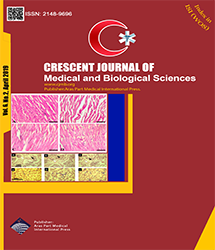
| Original Article | |
| Investigating the Relationship Between Hardness of Drinking-Water and Severity of Coronary Artery Disease Based on Angiographic Findings in East Azerbaijan Province, Iran | |
| Babak Nasiri1, Naser Khezerloy Aghdam1, Ahmad Separham1, Ramin Salmasi1, Nilgoon Daviran1, Raziyeh Parizad2, Mohammadreza Taban Sadeghi1 | |
| 1Cardiovascular Research Center, Tabriz University of Medical Sciences, Tabriz, Iran 2Faculty of Nursing and Midwifery, Tabriz University of Medical Sciences, Tabriz, Iran |
|
|
CJMB 2019; 6: 226-230 Viewed : 4465 times Downloaded : 2895 times. Keywords : Calcium, Magnesium, Hardness of drinking-water, Atherosclerosis |
|
| Full Text(PDF) | Related Articles | |
| Abstract | |
Objectives: Cardiovascular diseases (CVDs) are a major cause of hospital admission and the main reason for mortality in the world, which are triggered by both genetic and environmental factors. In addition, minerals and trace elements have long been considered potential risk factors for CVD among which calcium and magnesium may play a significant role. Accordingly, the present study aimed to assess the relationship between coronary atherosclerotic diseases and hardness of drinking-water in the residence of patients admitted to Shahid Madani hospital in Tabriz. Materials and Methods: The population of the study included 780 patients undergoing coronary angiography out of whom 547 cases were entered into this case-control study. The subjects were then divided into 5 groups based on the severity of coronary artery involvement: with the least or no involvement (control group), one artery involved (group 1), 2 arteries involved (group 2), 3 arteries involved (group 3), and severe diffuse involvement of all coronary arteries (group 4). Residences of the patients were located from their medical history and then 200-mL of drinking-water samples were then taken from each area in plastic containers. Next, the levels of calcium and magnesium were measured using the EDTA method. Finally, the samples were divided into 4 groups based on the hardness of water. Results:The mean age of the participants was 59.7 years and the most frequent type of water in the residential areas was the soft water. Further, the highest frequency related to the severity of atherosclerosis belonged to groups 4 and 3, respectively. Based on the results, no significant relationship was found either between the severity of atherosclerosis and calcium level of water or the severity of atherosclerosis and magnesium level of water. Conclusions: In general, the results revealed that there was no significant relationship between the levels of calcium and magnesium in the drinking water of the patients residing in East Azerbaijan province and their severity of atherosclerosis. The findings further suggest that the drinking water of the province can be divided into hard and soft water and the severity of atherosclerosis of the patients is independent of the hardness of the drinking water in their residences. |
Cite By, Google Scholar
Google Scholar
PubMed
Online Submission System
 CJMB ENDNOTE ® Style
CJMB ENDNOTE ® Style
 Tutorials
Tutorials
 Publication Charge
Medical and Biological Research Center
About Journal
Publication Charge
Medical and Biological Research Center
About Journal
Aras Part Medical International Press Editor-in-Chief
Arash Khaki
Deputy Editor
Zafer Akan


















